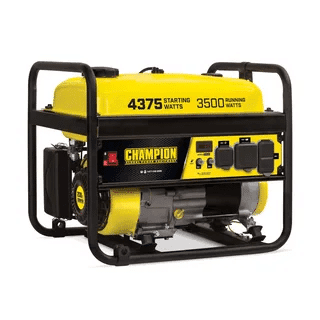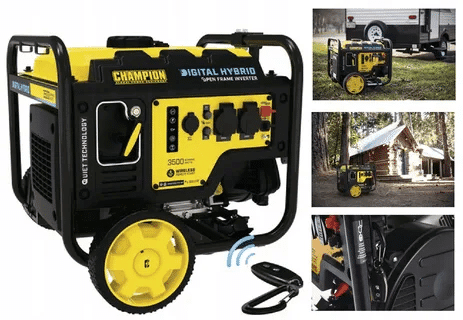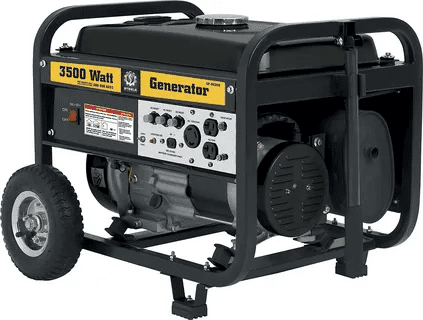Find out which appliances and devices a 3500 watt generator can use. Full book on home backup power, RV use, power calculations and tips on optimal use.
Understanding 3500 Watt Generator Capacity
The 3500 watts generator is a versatile mid-range-type of power source that closes the gap between smaller portable ones and large standby ones. A 3500W generator is a heavy-duty one with capabilities of operating most household items, providing emergency household power in an event of a power cut, and operating devices in a shop, a recreational vehicle, a new building site, and wherever power is not accessible. The definition of its capabilities requires awareness of running watts and starting watts, since they represent extent to which you can actually power.

Running watts indicate the power that your generator will sustain continuously to enable the appliances to operate normally. Starting watt also known as the surge watt represents the additional power surge of appliances with motors initially starting up. Majority of the 3500-watt generators are capable of an output of about 3500 watts during usage, just like they are capable of a surge of about 4000-4500 watts over a short course of time.
Essential Home Appliances a 3500 Watt Generator Can Run
Kitchen Appliances
Most of the typical kitchen appliances can be operated comfortably with your 3500-watt generator, but not all of them at the same time. An average fridge consumes 700-800 watts during use, 2200-2800 watts as it startup, which is nearly a simple task to provide by your generator. In some of the modern energy-efficient refrigerators, the amount of power consumed could lower to as low as 400-500 running watts.

The microwave cookers usually use 1000-1500 watts of electricity in their usage and this power can be absorbed easily by your generator. Coffee machines range between 800-1200 watts whereas food toasters require 800-1500 watts. Other appliances that can simply be run in concert with other appliances include small kitchen appliances such as blenders (300-500 watts), and food processors (400-750 watts).
But do not operate large wattage appliances such as electric stoves, ovens or large volume microwaves at the same time as any other major appliance since these may use 2000-3000 watts or more.
Heating and Cooling Systems
In the case of power failure, 3500W generator may also power all the needed appliances and elektronics like refrigerator, lights, sump pumps, heating/cooling systems. To heat, majority of furnace blower motors will require 600-1500 watts to run and as such will fit your generator. Space heater usually has consumption of 1000-1500 watts and you could afford to use one or two.
Air conditioning is more complicated. The air conditioner of 15000btu will not use much power of 1700 2000 watts, yet a 3.5kw can easily take this. But, window type version as well as the central air system require high startup requirements which require 3000-4000 watts to get it started. Once in operation they normally consume between 1200-2000 watts based on the size and the efficiency.
Lighting and Electronics
LED lighting systems are very generators friendly and the newer version of LED bulbs uses up to 8 to 15 watts per bulb. There is the potential of you running 3500 watts of electricity through an LED light which can power about 300 bulbs. A typical incandescent light bulb consumes 60-100 watts whereas a compact fluorescent type consumes 13-25 watts.
Appliances such as televisions (100-300 watts), computers (200-500 watts) and sound systems (100-800 watts) have little demands on your generator. Tablets, phone chargers and other small gadgets draw little or no power (usually less than 50 watts combined).
RV and Recreational Applications
RV Power Management
A 3500-watt quiet generator will power most of the RV appliances although you may not be in a position to use all the appliances at once. Due to their small sized and energy saving nature, the RV appliances consume less power and thus can be operated over long periods of time. The problem that RV generators will need to address are special considerations such as weight, noise levels and fuel consumption.
RV refrigerators usually run on Singe-twenty four volt (12V) DC or propane and use only 100-200 watts in AC. RV air conditioners however need due consideration. Once the RV AC has been started, they depend on roughly 1200watts, and as such they are manageable on 3500-watt generators, but the start up surge of the generator may reach 3000-3500 watts.
Camping and Outdoor Activities
A 3500-watt generator is extremely versatile to use during camping. Portable fridges, electric grills, fans, lighting systems and charging points of electronic devices could be run by you. Power tools can also be operated by the generator in case of repairs or in outdoor activities.
RV water-pumps generally drain 300-800 watts, whereas hot water heaters may want to use 1000-1500 watts. Even bright work lights or outdoor LED lights can easily fit inside the capacity of the generator as the LED string lights.
Power Tools and Workshop Equipment
Construction and Workshop Use
The 3500-watt generators are the best when it comes to running most of the common construction and workshop power tools. Circular saws usually need 1200-1800 watts whereas the table saws might require 1500-2500 watts. The drill motors also have 400-800 watts which means you can connect the majority with your generator with ease.
Compressors have fluctuated power demands. The small sized pancake compressors may require 1000-1500 watts but a larger sized shop compressor can require 2000-3000 watts running current with a surge of 4000-5000 watts. Get the right compressor and make it compatible.
Welders have a great range in terms of power needs. Small stick welders may require 1500-2500 watts and bigger units may surpass the strength of your generator. Specifications on the welder should always be verified and the duty cycle should be observed during the planning phase in case of continuous usage..
Yard and Garden Equipment
The electric chainsaws can run on about 1200-2000 watts, which means that they will fit in your generator. Typically, at least 400-600 watts will be needed to power a hedge trimmer but leaf blowers may use 800-1500 watts. Typical electric lawn mower uses 1000-1800 watts of steady operation power.
Irrigation or pool maintenance pumps usually are rated at 750-1500 watts, however, more powerful models may need more power. The average power that any pressure washer uses is 1500-2500 watts, making it a good match to your generator.
Calculating Your Power Needs
Understanding Wattage Requirements
The above calculation reveals that you require a generator with a minimum of 1400 whole running Watts and a 3500 whole starting Watts. Almost all appliances can be powered using 3500W generator but not at the same time. To get the best out of generators, there is a need to make computations of the running and starting watts of all desired appliances.
Make a list of the entire appliances you want to use at one time. Add the running watts, then find out the greatest starting watts requirement among your appliances. The total watts of running and the maximum starting watt of all the combinations must be within the capacity of your generator.
Load Management Strategies
Intelligent load management blows the capacity of your generator to new heights. Use priority and power demand to rotate the use of all appliances so that not all of them are used at the same period. The high-surge appliances should be started one by one to prevent overloading the generator upon starting.
Investigate the use of power load management system or manual transfer switch that can control which circuits power is supplied to. This will avoid the problem of inadvertent overload, and will guarantee that important appliances are supplemented with the same power during an outage.
Safety and Efficiency Tips
Proper Installation and Setup
Do not use your generator in a closed space or indoors because of carbon monoxide. Keep over 20 feet away of the windows, doors, and vents. Take the proper extension cords that are suitable to be used outside and that has a capacity equal to that of the generator.
Install a transfer switch in permanent home back up use. The apparatus guards against hazardous backfeeding of utility lines and eases the change over between utility and generator power. Code conformity and maximum safety will be provided by professional installation.
Maintenance and Fuel Management
The maintenance will result in dependability and a prolonged working life of generators. Whether you be it every 50 to 100 operation hours you should change oil, regularly change air filters and keep fuel systems clean. To store fuel long-term to use, apply fuel stabilizers and ethanol-free gasoline on better engine performance.
Check the fuel usage to calculate the run-time. The 3500- watt generators use 0.3 to 0.5 gallons every hour, with 50 percent loading; this gives them 8 and 12 hours of fuel with the full tank. Supplies of fuel should also be planned during longer disruptions.
Limitations and Considerations
What You Cannot Run
Knowing some limitations helps not to break equipment and to work out safely. Appliances that draw a lot of power such as the electric water heater (3000-4500 watts), electric dryer (3000-5000 watts), electric range (3000-8000 watts) usually consume more than what your generator can actually handle.
The size of the air conditioning system, especially the central air with a cooling capacity greater than 3 tons usually needs bigger power than the 3500-watt generating capacity offers. Equally, large workshop items such as cabinet saws, industrial compressors and large amperage welders can also be over loaded.
Environmental Factors
Temperature influences the performance of the generators, whereby, the power output goes down during extreme hot or cold weather. Even performance is affected by altitude, and power produced drops at a rate of about 3.5 percent per 1000 feet of altitude. Consider dealing with them when there are difficult situations.
Performance and safety are influenced by the humidity and weather conditions. Place your generator in a dry and rain-free environment but ensure that it is well ventilated. Think of a shelter or cover suitable in protecting a generator against bad weather.
Conclusion
The combination of 3500-watts of generator power offers the utmost flexibility in home backup power, RV applications and portable power. It will generally be able to run most of the everyday household items, such as power tools, small appliances, and even sporting equipment, but planning keeps it out of trouble. Knowing how to set up different running watts and starting watts, setting up smart load management, and practicing the right safety precautions is what will enable you to get the best out of your investment in both the short and long-term.

